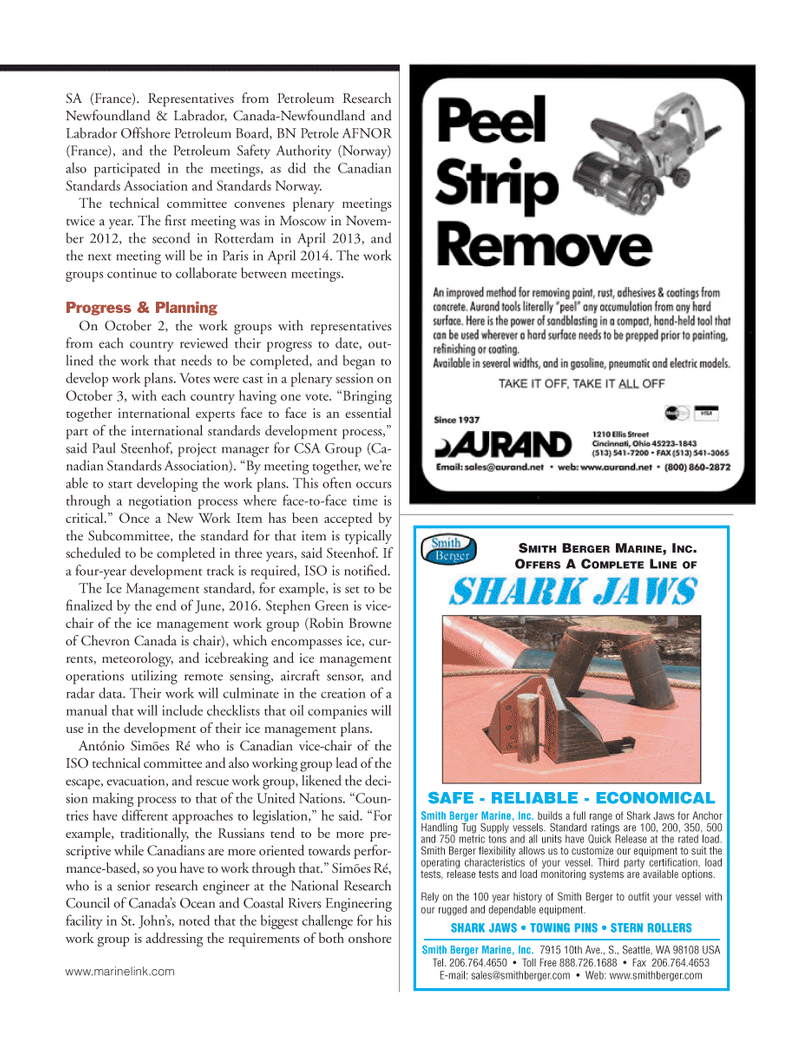
Page 29: of Marine News Magazine (January 2014)
Tug Boat Technology
Read this page in Pdf, Flash or Html5 edition of January 2014 Marine News Magazine
SA (France). Representatives from Petroleum Research
Newfoundland & Labrador, Canada-Newfoundland and
Labrador Offshore Petroleum Board, BN Petrole AFNOR (France), and the Petroleum Safety Authority (Norway) also participated in the meetings, as did the Canadian
Standards Association and Standards Norway.
The technical committee convenes plenary meetings twice a year. The fi rst meeting was in Moscow in Novem- ber 2012, the second in Rotterdam in April 2013, and the next meeting will be in Paris in April 2014. The work groups continue to collaborate between meetings.
Progress & Planning
On October 2, the work groups with representatives from each country reviewed their progress to date, out- lined the work that needs to be completed, and began to develop work plans. Votes were cast in a plenary session on
October 3, with each country having one vote. “Bringing together international experts face to face is an essential part of the international standards development process,” said Paul Steenhof, project manager for CSA Group (Ca- nadian Standards Association). “By meeting together, we’re able to start developing the work plans. This often occurs through a negotiation process where face-to-face time is critical.” Once a New Work Item has been accepted by the Subcommittee, the standard for that item is typically scheduled to be completed in three years, said Steenhof. If a four-year development track is required, ISO is notifi ed.
The Ice Management standard, for example, is set to be fi nalized by the end of June, 2016. Stephen Green is vice- chair of the ice management work group (Robin Browne of Chevron Canada is chair), which encompasses ice, cur- rents, meteorology, and icebreaking and ice management operations utilizing remote sensing, aircraft sensor, and radar data. Their work will culminate in the creation of a manual that will include checklists that oil companies will use in the development of their ice management plans.
António Simões Ré who is Canadian vice-chair of the
ISO technical committee and also working group lead of the escape, evacuation, and rescue work group, likened the deci- sion making process to that of the United Nations. “Coun- tries have different approaches to legislation,” he said. “For example, traditionally, the Russians tend to be more pre- scriptive while Canadians are more oriented towards perfor- mance-based, so you have to work through that.” Simões Ré, who is a senior research engineer at the National Research
Council of Canada’s Ocean and Coastal Rivers Engineering facility in St. John’s, noted that the biggest challenge for his work group is addressing the requirements of both onshore
Smith Berger Marine, Inc. builds a full range of Shark Jaws for Anchor
Handling Tug Supply vessels. Standard ratings are 100, 200, 350, 500 and 750 metric tons and all units have Quick Release at the rated load.
Smith Berger flexibility allows us to customize our equipment to suit the operating characteristics of your vessel. Third party certification, load tests, release tests and load monitoring systems are available options.
Rely on the 100 year history of Smith Berger to outfit your vessel with our rugged and dependable equipment.
SMITH BERGER MARINE, INC.
OFFERS A COMPLETE LINE OF
SHARK JAWS • TOWING PINS • STERN ROLLERS
Smith Berger Marine, Inc. 7915 10th Ave., S., Seattle, WA 98108 USA
Tel. 206.764.4650 • Toll Free 888.726.1688 • Fax 206.764.4653
E-mail: [email protected] • Web: www.smithberger.com
SAFE - RELIABLE - ECONOMICAL www.marinelink.com
MN JAN14 Layout 18-31.indd 29 12/20/2013 10:08:06 AM

 28
28

 30
30
